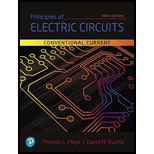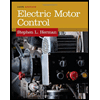
EBK PRINCIPLES OF ELECTRIC CIRCUITS
10th Edition
ISBN: 9780134880068
Author: Buchla
Publisher: VST
expand_more
expand_more
format_list_bulleted
Textbook Question
Chapter 1, Problem 7RP
Divide 8 × 10−6 by 2 × 10−10.
Expert Solution & Answer
Want to see the full answer?
Check out a sample textbook solution
Students have asked these similar questions
Design and find values. please solve ASAP
(it's for practice before an exma, I don't have time)
Can you show why the answer is that for this question using second order differential equations, instead of laplace transforms
2. For each of the following transfer functions,
G(s) = Y(s)/U(s), find the differential equation
relating the input u(t) to the output y(t).
(s+2)(s+3)
(a) G(s) =
(s+1)(s+4)
(s²+0.4s+1.04) (s+3)
(b) G(s)=
(s2+0.2s+1)(s+2)(s+4)
Chapter 1 Solutions
EBK PRINCIPLES OF ELECTRIC CIRCUITS
Ch. 1 - Express 4,750 in scientific notation.Ch. 1 - Express 0.00738 in scientific notation.Ch. 1 - Express 9.12 103 as a regular decimal number.Ch. 1 - Add 3.1 103 and 5.5 104.Ch. 1 - Subtract 3.5 106 from 2.2 105.Ch. 1 - Multiply 3.2 106 and 1.5 103.Ch. 1 - Divide 8 106 by 2 1010.Ch. 1 - Express 36,000,000,000 in engineering notation.Ch. 1 - Express 0.0000000000056 in engineering notation.Ch. 1 - Express using metric prefixes: 1. 56,000 2....
Ch. 1 - Convert 1 mA to microamperes.Ch. 1 - Convert 1,000 mV to millivolts.Ch. 1 - Convert 893 nA to microamperes.Ch. 1 - Convert 10,000 pF to microfarads.Ch. 1 - Convert 0.0022 mF to picofarads.Ch. 1 - Convert 2.2 k to megohms.Ch. 1 - Add 2,873 mA to 10,000 mA; express the sum in...Ch. 1 - How would you show the number 10,000 showing three...Ch. 1 - What is the difference between a measured quantity...Ch. 1 - Round 3.2850 to three significant digits using the...Ch. 1 - Derived units in the SI system use base units in...Ch. 1 - The base electrical unit in the SI system is the...Ch. 1 - The supplementary SI units are for angular...Ch. 1 - The number 3,300 is written as 3.3 103 in both...Ch. 1 - A negative number that is expressed in scientific...Ch. 1 - When you multiply two numbers written in...Ch. 1 - When you divide two numbers written in scientific...Ch. 1 - The metric prefix micro has an equivalent power of...Ch. 1 - To express 56 106 with a metric prefix, the...Ch. 1 - 0.047 F is equal to 47 nFCh. 1 - 0.010 F is equal to 10,000 pF.Ch. 1 - 10,000 kW is equal to 1 MW.Ch. 1 - The number of significant digits in the number...Ch. 1 - To express 10,000 with three significant figures,...Ch. 1 - When you apply the round-to-even rule to round off...Ch. 1 - If a series of measurements are precise, they must...Ch. 1 - The base SI electrical unit is the ampere.Ch. 1 - Which of the following is not an electrical...Ch. 1 - The unit of current is a. volt b. watt c. ampere...Ch. 1 - The number of base units in the SI system is a. 3...Ch. 1 - An mks measurement unit is one that a. can be...Ch. 1 - In the Sl system, the prefix k means to multiply...Ch. 1 - Prob. 6STCh. 1 - The quantity 4.7 103 is the same as a) 470 b)...Ch. 1 - The quantity 56 103 is the same as a. 0.056 b....Ch. 1 - Prob. 9STCh. 1 - Ten milliamperes can be expressed as a. 10 MA b....Ch. 1 - Five thousand volts can be expressed as a. 5,000 V...Ch. 1 - Twenty million ohms can be expressed as a. 20 m b....Ch. 1 - Prob. 13STCh. 1 - When reporting a measured value, it is okay to...Ch. 1 - Express each of the following numbers in...Ch. 1 - Express each fractional number in scientific...Ch. 1 - Express each of the following numbers in...Ch. 1 - Express each of the following numbers in...Ch. 1 - Express each of the following numbers in...Ch. 1 - Express each of the following as a regular decimal...Ch. 1 - Express each of the following as a regular decimal...Ch. 1 - Express each number in regular decimal form: a....Ch. 1 - Add the following numbers: a. (9.2 106) + (3.4 ...Ch. 1 - Prob. 10PCh. 1 - Perform the following multiplications: a. (5 ...Ch. 1 - Prob. 12PCh. 1 - Perform the indicated operations: a. (8 104 + 4 ...Ch. 1 - Starting with 1012, list the powers of ten in...Ch. 1 - Express each of the following numbers in...Ch. 1 - Express each number in engineering notation: a....Ch. 1 - Express each number in engineering notation: a....Ch. 1 - Express each number in engineering notation: a....Ch. 1 - Add the following numbers and express each result...Ch. 1 - Multiply the following numbers and express each...Ch. 1 - Divide the following numbers and express each...Ch. 1 - Express each number in Problem 15 in ohms using a...Ch. 1 - Express each number in Problem 17 in amperes using...Ch. 1 - Express each of the following as a quantity having...Ch. 1 - Express the following using metric prefixes: a. 3 ...Ch. 1 - Express the following using metric prefixes: a....Ch. 1 - Express each quantity by converting the metric...Ch. 1 - Express each quantity in engineering notation: a....Ch. 1 - Perform the indicated conversions: a. 5 mA to...Ch. 1 - Determine the following: a. The number of...Ch. 1 - Add the following quantities: a. 50 mA + 680 A b....Ch. 1 - Do the following operations: a. 10 k (2.2 k + 10...Ch. 1 - How many significant digits are in each of the...Ch. 1 - Round each of the following numbers to three...
Additional Engineering Textbook Solutions
Find more solutions based on key concepts
Convert each of the following binary representations to its equivalent base ten form: a. 101010 b. 100001 c. 10...
Computer Science: An Overview (13th Edition) (What's New in Computer Science)
What types of coolant are used in vehicles?
Automotive Technology: Principles, Diagnosis, And Service (6th Edition) (halderman Automotive Series)
The ____________ is always transparent.
Web Development and Design Foundations with HTML5 (8th Edition)
Write a summary list of the problem-solving steps identified in the chapter, using your own words.
BASIC BIOMECHANICS
How does a computers main memory differ from its auxiliary memory?
Java: An Introduction to Problem Solving and Programming (8th Edition)
Knowledge Booster
Learn more about
Need a deep-dive on the concept behind this application? Look no further. Learn more about this topic, electrical-engineering and related others by exploring similar questions and additional content below.Similar questions
- Don't use ai to answer I will report you answerarrow_forward5. A schematic diagram of a motor connected to a load by gears is shown. Both the motor and the load are modeled as rotating masses with viscous damping. Find the transfer functions Øm/Tm and ØL/Tm. bm Jm Tm 0m N₂ N₁ OL но JL b₁arrow_forward3. Find the transfer function X2/F of the mechanical system in Figure. Κι www b₁ M₁ K2 www M2 b2 X2 F b3arrow_forward
- S1(t) Es/Ts 0 S3(t) 0 Es/Ts Ts t S2(t) Es/Ts 0 Es/Ts Ts |7|2 S4(t) Es/Ts t Ts t 0 Ts Ts Ts Es/TS 2 1/ Q1(t) 42(t) Ts 1JT 0 t 0 Ts Ts 2 32 FIGURE 7.3 Set of signals and orthonormal functions for Example 7.1. 53(t)=√√Esq₁(t) S4(t)=-√E542(t) t Tsarrow_forward1. For each of the following differential equations, determine the transfer function Y/U. Determine if the transfer function is proper or strictly proper. is not strictly proper, determine the strictly proper part. If it (a) y(3) = -3y(2) - 3y(1) — 2y + u(2) — - (b) y(3)=-3.5y(2) — 3.5y(1) — y +u(3) — 3.5u(2) + 3.5u(¹) + 3uarrow_forward.4. Find the transfer function Ø2/T of the mechanical system in Figure. TG K 02 b₁ b₂ b3arrow_forward
- Matlab problem: 1) A BFSK signal is transmitted through a channel with AWGN. Generate similar BFSK received signal plots as shown below. (20 pts) BFSK for eb=1 and npower=0.01 with 500 samples BFSK for eb=1 and npower=0.1 with 500 samples 2.5 2.5 2 1.5 1 0.5 0 -0.5 -1 2 1.5 1 0.5 0.5 -1 -1.5 1.5 -1.5 -1 -0.5 0 0.5 1.5 2 2.5 -1.5 -0.5 0 0.5 1 1.5 2 2.5arrow_forwardexample 7.1 question EXAMPLE 7.1Consider the signals s1(t), s2(t), s3(t), and s4(t) shown in Figure 7.3. Using the Gram-Schmidt orthogonalization procedure, determine a set of orthonormal basis functions.Using the waveforms derived and shown in Example 7.1:a) Sketch the simplified block diagram of the transmitter and receiver as shown in figure 7.2b) Estimate the receive voltages for each transmit signal and for each branch in the receiver.arrow_forwardEXAMPLE 7.2 Consider the two equally-likely signals s₁ (t) and s2(t) that are transmitted, over an AWGN channel with the noise power spectral density of No/2, to represent bits 1 and 0, where we have: S1(t)=-S2(t)=√√2 exp(-2t)u(t) The receiver makes its decision solely based on observation of the received signal over a restricted interval of interest. Determine the average bit error rate in terms of Q-function, assuming the interval is [0,3]. Contrast numerically with the performance of an optimum receiver that observes. all the received signal, i.e., the interval of interest is (-∞, ∞).arrow_forward
- 1) Compute the voltages at each receiver branch (Vo ad V₁ see block diagram next page) for each of the possible transmitted signals: Transmitted signals are generated as shown below: Binary wave in unipolar form (a) With basis functions: Inverter 41(t) Product modulator Product modulator 42(t) BFSK + signal + Si(t) P1(t)= √Eb = cos (2лfit+0₁) $2(t) 42(t)= √Eb 层 cos (2лf2t+ t+02) Generating signals: 2E Si(t) cos (2лfit+0₁), bit=0 Ть SBFSK (t) 2E |$2(t)= cos (2лf2t+02), bit=1arrow_forwardFind the disruptive voltage and visual corona voltage for 3-phase line consisting of 2.5 cm diameter conductor spaced equilateral triangular formation of 4 m. The following data can be assumed, temperature 25°c, pressure 73 cm of mercury, surface factor 0.84, irregularity factor 0.72.arrow_forwardA 3-phase, 4-wire distributor supplies a balanced voltage of 400/230 V to a load consisting of 8 A at p.f. 0-7 lagging for R-phase, 10 A at p.f. 0-8 leading for Y phase and 12 A at unity p.f. for B phase. The resistance of each line conductor is 0.4 2. The reactance of neutral is 0.2 2. Calculate the neutral current, the suppl voltage for R phase and draw the phasor diagram. The phase sequence is RYB. VR Phasor diagramarrow_forward
arrow_back_ios
SEE MORE QUESTIONS
arrow_forward_ios
Recommended textbooks for you
 Delmar's Standard Textbook Of ElectricityElectrical EngineeringISBN:9781337900348Author:Stephen L. HermanPublisher:Cengage Learning
Delmar's Standard Textbook Of ElectricityElectrical EngineeringISBN:9781337900348Author:Stephen L. HermanPublisher:Cengage Learning

Delmar's Standard Textbook Of Electricity
Electrical Engineering
ISBN:9781337900348
Author:Stephen L. Herman
Publisher:Cengage Learning

Types of Systems; Author: Neso Academy;https://www.youtube.com/watch?v=IRdDcSO_fQw;License: Standard youtube license